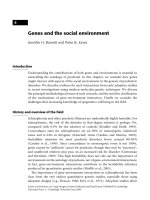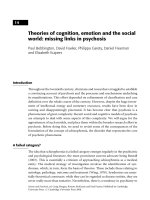Goods and services (social studies)
Bạn đang xem bản rút gọn của tài liệu. Xem và tải ngay bản đầy đủ của tài liệu tại đây (2.7 MB, 12 trang )
Suggested levels for Guided Reading, DRA,™
Lexile,® and Reading Recovery™ are provided
in the Pearson Scott Foresman Leveling Guide.
Goods
and
Services
by Megan Litwin
Genre
Expository
nonfiction
Comprehension
Skills and Strategy
• Main Idea
• Sequence
• Text Structure
Text Features
• Diagrams
• Headings
• Glossary
Scott Foresman Reading Street 2.5.1
ISBN 0-328-13294-2
ì<(sk$m)=bdcjec< +^-Ä-U-Ä-U
Reader Response
1. What is the main idea of this book?
2. You read about Sarah and the baker on
pages 7 and 9. List the steps that the
baker had to follow in order to sell the
and to Sarah. Use a chart like
banana bread
the one below to help you organize
by Megan Litwin
your ideas.
Goods
Services
3. List five different kinds of services you
or your family buy.
4. Where in the book would you find the
meaning of the word responsible?
Editorial Offices: Glenview, Illinois • Parsippany, New Jersey • New York, New York
Sales Offices: Needham, Massachusetts • Duluth, Georgia • Glenview, Illinois
Coppell, Texas • Ontario, California • Mesa, Arizona
Every effort has been made to secure permission and provide appropriate credit for
photographic material. The publisher deeply regrets any omission and pledges to
correct errors called to its attention in subsequent editions.
Unless otherwise acknowledged, all photographs are the property of Scott Foresman,
a division of Pearson Education.
Photo locators denoted as follows: Top (T), Center (C), Bottom (B), Left (L), Right (R),
Background (Bkgd)
Opener: Bill Aron/PhotoEdit; 1 ©DK Images; 3 (TR) Getty Images, (TC) PhotoEdit; 4
(CL) Royalty-Free/Corbis, (BL, BR) ©DK Images; 5 Getty Images; 6 ©DK Images; 7 Bill
Aron/PhotoEdit; 8 (CL) ©DK Images, (BR) Getty Images; 9 (TL) Royalty-Free/Corbis, (TC)
Andreas Buck/Das Fotoarchiv/Peter Arnold, Inc. (TR) Getty Images, (CR, B) ©DK Images;
11 (BR) ©DK Images, PhotoEdit; 12 Christopher Bissell/Getty Images; 13 (CL, CR) Getty
Images, (C) ©Comstock Inc.; 14 Getty Images; 15 (BL) ©DK Images, (BR) Tony Freeman/
PhotoEdit; 17 ©DK Images; 18 PhotoEdit
ISBN: 0-328-13294-2
Copyright © Pearson Education, Inc.
All Rights Reserved. Printed in the United States of America. This publication is
protected by Copyright, and permission should be obtained from the publisher
prior to any prohibited reproduction, storage in a retrieval system, or transmission
in any form by any means, electronic, mechanical, photocopying, recording, or
likewise. For information regarding permission(s), write to: Permissions Department,
Scott Foresman, 1900 East Lake Avenue, Glenview, Illinois 60025.
2 3 4 5 6 7 8 9 10 V010 14 13 12 11 10 09 08 07 06 05
What are goods?
Take a look around your home. It is
probably full of things. You may have
food in your kitchen, a tub in your
bathroom, and a backpack. These things
are all called goods. Goods are things
that can be bought or sold.
Making goods takes teamwork. Some
people work together to make goods.
Then other people work together to
bring goods to stores. People buy goods
and bring them home.
3
Where do goods come from?
Fruit and furniture are examples of
goods. Where does the fruit you eat
come from? Fruit is sold in food stores.
Before it was brought to the store,
farmers grew the fruit on a farm. Then
workers washed it, packaged it, and
shipped it to stores. Finally someone
bought it and it came to you!
The furniture in your house may have
been bought from a furniture store,
but the furniture had to come from
somewhere first.
People who are trained to make
things out of wood are called
carpenters. Some carpenters build
furniture, and some build whole houses!
People who grow or make goods
are called producers. People who buy
the goods are called consumers. In a
community, producers and consumers
need each other.
Let’s take a closer look at some
examples of producers and consumers
helping each other in a community.
Trees
Shelves
Boards
4
5
Producers and Consumers
Do you like bread? If you buy and eat
bread, you are a consumer. Where does
your bread come from?
One place where you could get bread
is a bakery. Goods that come from a
bakery are called baked goods. A baker
is someone who makes baked goods to
sell to other people.
A baker is a producer of bread.
The baker and the community need
each other. How does a baker work with
other people in the community? Let’s
find out.
Today is Sarah’s birthday. Sarah needs
the baker to produce banana bread so
she can have a birthday treat. The baker
needs Sarah to buy his goods. If people
did not buy the baker’s goods, he might
have to close his store.
Bakeries and other stores need
consumers to buy their goods.
Sell at a bakery
Bake the bread
Mix the dough
6
7
It is not quite that simple, though.
Let’s think back to that banana bread. It
contained many ingredients. The baker
needed a supply of bananas, flour, and
butter in order to bake it. Where did
those things come from?
The baker did not have time to grow
the bananas or to make the flour and
butter. The baker had to buy those
ingredients. When he bought those
ingredients, he was the consumer. The
baker had to be a consumer before he
could be a producer.
Ingredients from many producers are
needed to make banana bread.
8
9
There are many other types of goods
that we need. Food, clothing, and
furniture are all examples of goods that
we buy. We also buy goods such as toys,
books, and toothpaste.
Every time you buy something, you
are a consumer. The money you spend
helps the producer create more goods
to sell.
Kids can sometimes be producers too.
Have you ever had a lemonade stand?
When you make lemonade to sell, you
are the producer. The people who buy
your lemonade are consumers.
Have you ever sold
lemonade at a
lemonade stand?
10
11
What are services?
Sometimes, instead of needing
things, we need someone to do a job or
help us get something done. If you need
a haircut, you might go to a hairdresser
or a barber. If your parents are going
out for the evening, they might call a
babysitter to take care of you while they
are gone. When someone does a job for
others, that is called a service.
Goods and services are similar. The
people who provide services are also
producers. The people who pay for their
services are consumers.
12
Let’s look at an example. Timothy
needs to have his hair cut. He goes to
the barber. The barber cuts Timothy’s
hair. Timothy pays the barber money for
that service. Timothy is the consumer. He
is paying for the services of the barber.
The barber is the producer. He is selling
the service of cutting hair.
13
The barber needs many tools to do
his job. He needs scissors, shampoo,
towels, and chairs. He must buy those
goods so he can provide his service.
When the barber buys tools, he is a
consumer. He needs other people to
make, or produce, those tools. Many
people work to provide goods to the
community.
The barber buys these tools
from other producers.
14
Many people also provide services to
the community. Some services, such as
the services of teachers, firefighters, and
police officers, are paid for by the local
government.
When a car needs to be fixed, you
might go to an auto mechanic for repair
service. Doctors, the phone company,
and bus drivers all offer services. Can
you think of other examples?
This woman is a mechanic who services the
community by fixing cars.
15
All the people in a community need
each other. Sarah needs the baker to
make her banana bread. The baker
needs farmers and other producers
to grow and sell the bananas for that
bread.
Timothy needs the barber to get his
hair cut. The barber needs to buy special
tools from other producers before he
can provide his service.
16
Each producer is responsible for
doing a good job. Because producers
and consumers need each other, when
goods or services are not done well,
many people are affected. Consumers
have a choice. They want to buy the best
goods and services they can find and pay
for. If producers do their best work, they
make the whole community better.
17
Now Try This
Think about goods that you buy or
consume. Choose one and think about
all the people who work together to
produce it.
You many need to research where it
comes from. Many goods in the United
States depend on the work of producers
in other countries.
18
to Do It!
w
o
H
s
’
e
r
He
Make a chart like the one below. In
the boxes record the producers who
worked on making the goods you buy.
19
Glossary
Reader Response
community n. a
group of people
living and working
together.
responsible adj.
expected to take
care of someone or
something.
consumers n.
people who buy
goods and services.
service n. a job
that someone does
for others.
goods n. things
that can be bought
or sold.
teamwork n. the
combined action of
a group of people
that makes the
work of the group
successful.
producers n.
people who grow,
make, or create
something to sell.
1. What is the main idea of this book?
2. You read about Sarah and the baker on
pages 7 and 9. List the steps that the
baker had to follow in order to sell the
banana bread to Sarah. Use a chart like
the one below to help you organize
your ideas.
3. List five different kinds of services you
or your family buy.
4. Where in the book would you find the
meaning of the word responsible?
20









